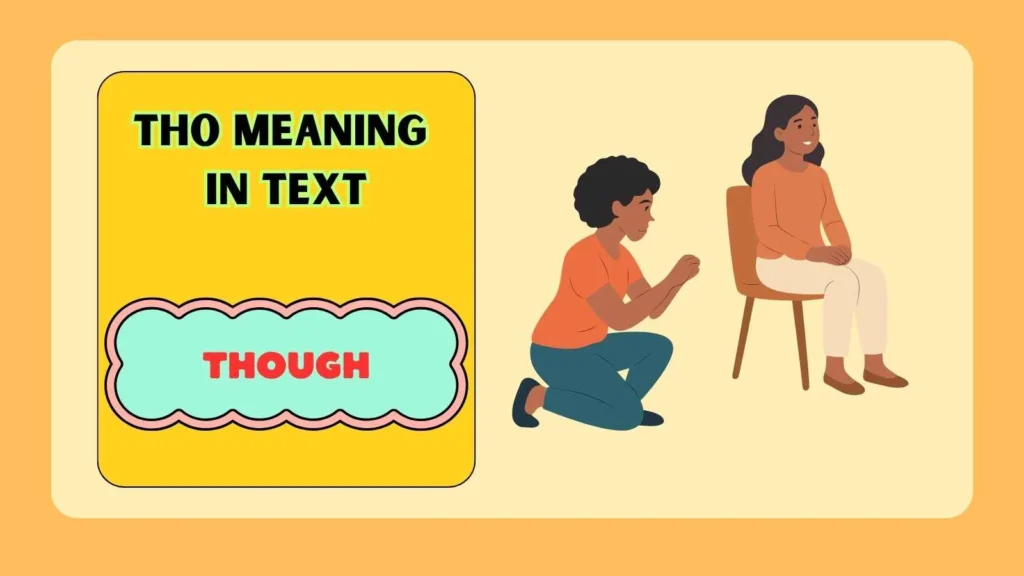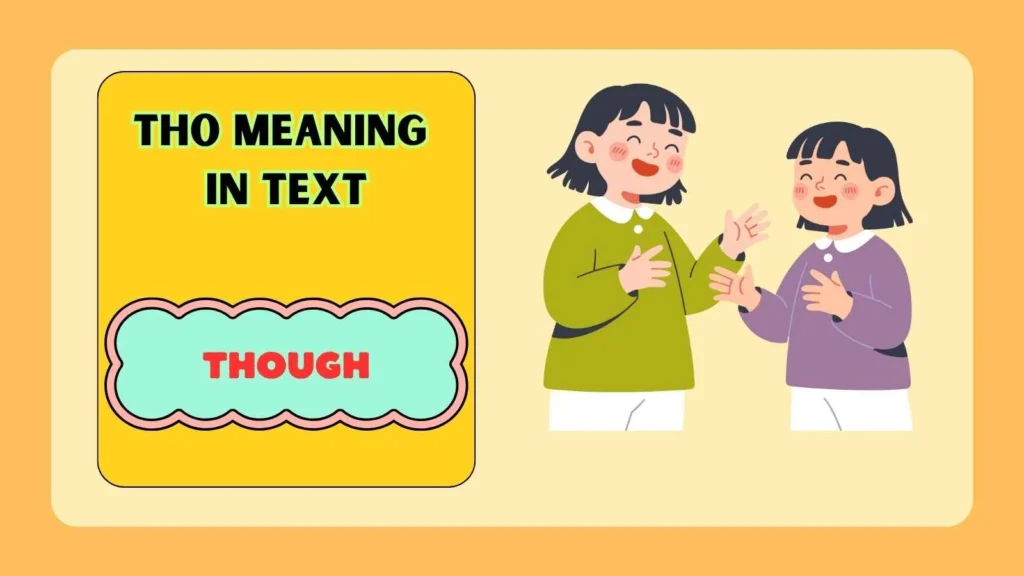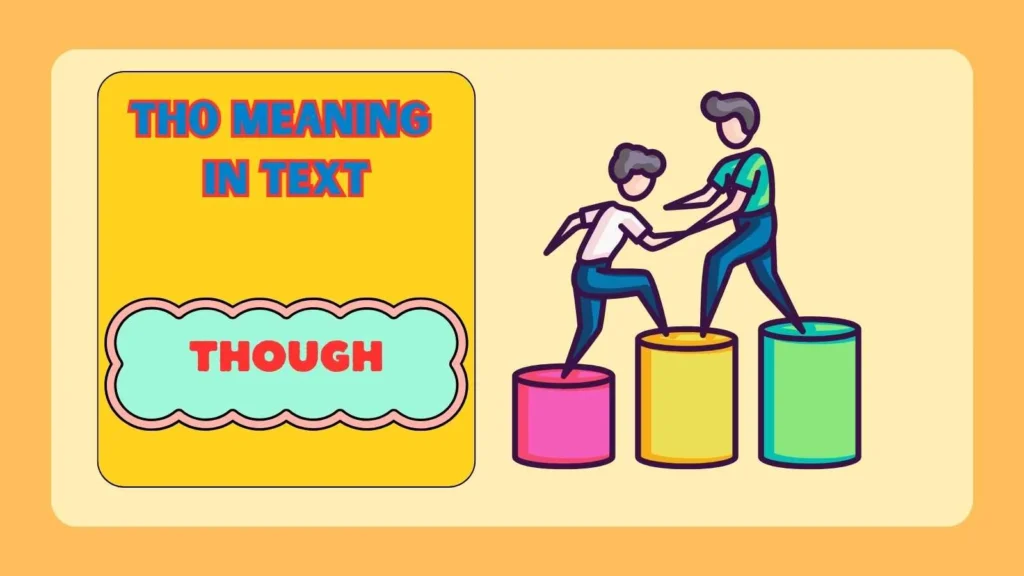Last updated on October 31st, 2025 at 10:48 pm
If you’ve ever texted someone and seen the word “tho” pop up, you’re not alone in wondering what it means. In the fast-paced world of texting and online slang, “tho” has become one of the most popular shorthand expressions used across social media, chats, and even memes. It’s short, casual, and adds a punch of emotion or emphasis to digital conversations.
But while it seems simple, its tone can shift depending on how and where it’s used. Some use it to soften a statement, others to sound playful or sarcastic. Because of its versatility, “tho” keeps evolving with internet culture and Gen Z language trends.
This article breaks down everything about tho meaning in text from its origin and tone to how to respond and when to avoid it in formal settings. Let’s decode the tiny word that carries a big vibe.
Definition & Meaning
In texting and online communication, “tho” is an informal abbreviation of the word “though.” It’s used mainly at the end of sentences to add contrast, emphasis, or a casual tone. For example:
- “That outfit is cute tho.”
Here, tho adds a hint of admiration or emphasis that might not come across if you just said, “That outfit is cute.”
Essentially, tho softens or stylizes speech—it’s less formal and more expressive. It’s a staple of Gen Z and Millennial communication because it mirrors how people actually talk. In online chats, tone matters, and tho helps convey feelings that plain text can’t—such as humor, sass, or irony.
In short, “tho” means “however”, “yet”, or “still”—but with a chill, modern twist that fits perfectly into digital slang.
Background & History
The term “tho” isn’t new it’s a simplified spelling of “though” that has existed in English for centuries. However, its rise in texting culture started around the early 2000s, when people began shortening words for speed and style in online messaging.
As texting became mainstream, especially on platforms like Twitter, Tumblr, and later TikTok, tho became part of the internet aesthetic. It wasn’t just about convenience anymore—it was about attitude.
By the 2010s, tho was being used not only in texts but in memes, captions, and tweets to express subtle emotion or humor. The no-h in tho gave it a more casual and modern tone, distinguishing it from its formal origin.
Today, tho is recognized globally as one of the most widely used informal connectors in digital communication, proving that even small tweaks in language can shape online culture.
Usage in Various Contexts
The meaning of tho can change depending on where and how it’s used.
1. Casual Texting:
Used to express contrast or emphasis.
- “It’s expensive tho.” → Adds slight surprise or acceptance.
2. Compliments:
Adds charm or playfulness.
- “You look good tho.” → Friendly and flirty at the same time.
3. Memes & Humor:
Used to exaggerate reactions or emotions.
- “That cat looks angry tho 😭”
4. Online Debates:
Softens strong opinions.
- “You have a point tho.”
5. Aesthetic Posts:
Used for emphasis in captions or tweets.
- “Not me eating again tho 💀”
It’s flexible, expressive, and fits in both light-hearted and serious conversations. The key is tone—tho often adds a playful or reflective edge.
Common Misconceptions & Clarifications
Many misunderstand tho because of its simplicity. Here are a few clarifications:
- Myth: It’s incorrect English.
Fact: It’s informal, not incorrect. It’s accepted in casual texting but avoided in formal writing. - Myth: It’s just short for though.
Fact: True in spelling, but tho carries modern tone and emotional nuance that though doesn’t. - Myth: It always means “however.”
Fact: Not necessarily—it can also mean “still,” “yet,” or even express admiration depending on context. - Myth: It’s rude or dismissive.
Fact: Tone matters. When used playfully, it can actually sound friendly or funny.
Understanding these nuances helps you use tho effectively in online communication.
Similar Terms & Alternatives
If you want to vary your texting style, here are a few words similar to tho:
- However – Formal version; used in professional or academic settings.
- Still – Implies persistence or continuation.
- Yet – Adds contrast but sounds more neutral.
- Anyway – Used to shift or redirect conversations.
- But – Simple and direct, used to contrast ideas.
Each has its own tone. Tho stands out for its personality—it keeps things informal and expressive without overcomplicating your message.
How to Respond to This Term
When someone uses tho in a message, your reply depends on tone:
- Flirty tone:
“You look good tho.”
→ Respond: “You’re not so bad yourself 😉” - Casual tone:
“It was fun tho.”
→ Respond: “Yeah, I had a good time too!” - Serious tone:
“It’s tough tho.”
→ Respond: “True, but we’ll figure it out.”
Matching the vibe keeps the conversation natural. Overanalyzing can make it awkward—so keep it light and fun.
Regional or Cultural Differences
While tho is globally recognized, its use and tone vary slightly by region:
- US & Canada: Common among Gen Z and Millennials; used for emphasis or sarcasm.
- UK: Similar usage but slightly less frequent; often replaced with “innit” or “still.”
- Australia & New Zealand: Popular in memes and casual texts.
- Asia: Frequently used in online English conversations among youth for a Western touch.
In all cases, tho adds informality and emotion—making digital chats sound more human.
Comparison with Similar Terms
Comparing tho with its original form though helps clarify its unique role:
| Aspect | Though | Tho |
|---|---|---|
| Formality | Formal | Informal |
| Usage | Writing & Speech | Texting & Online |
| Tone | Neutral | Casual, emotional |
| Purpose | Logical connector | Stylistic expression |
While though belongs in essays or formal emails, tho thrives in Instagram captions, DMs, and tweets. Think of it as the cool cousin of proper grammar—less about correctness, more about connection.
Usage in Online Communities & Dating Apps
In online spaces and dating apps, tho often adds subtle tone and charm:
- Flirty Example: “You’re kinda cute tho 👀” → Light teasing or interest.
- Playful Example: “Didn’t expect that reply tho 😂”
- Reflective Example: “We had a good chat tho.”
On platforms like TikTok, Twitter, and Bumble, it’s used to appear relatable, fun, or emotionally open. It’s a micro-expression that tells others you’re casual yet expressive—perfect for digital chemistry.
Hidden or Offensive Meanings
Unlike some slang terms, tho doesn’t carry any offensive meaning. However, tone and context can make it sound dismissive if used incorrectly.
For instance:
- “Nice try tho.” → Could sound sarcastic or condescending if not paired with friendly tone or emoji.
Always consider how your message might be received. Adding emojis or softening words can prevent misunderstanding.
Suitability for Professional Communication
In formal emails, reports, or professional chats, avoid using tho. It can come across as too casual or unprofessional. Instead, use:
- However
- Nevertheless
- Even though
Save tho for texting friends, social media, or informal messages where tone matters more than grammar.
💫 Tho Meaning in Instagram

- 📱 On Instagram, “tho” means “though,” adding emphasis or contrast in captions.
- 💬 It’s often used to soften opinions, like “That outfit’s cute tho 👀.”
- ✨ Influencers use it to sound casual yet confident in comments.
- 🔥 “Tho” helps posts feel more authentic and less scripted.
- 🧠 It bridges ideas smoothly — “simple tho stylish.”
- 💞 It adds friendly energy without formal grammar.
- 🎯 Using “tho” keeps captions short but expressive, perfect for scroll culture.
- 😍 It helps show personality — funny, chill, or flirty tone.
- 📊 Posts with slang like “tho” often get higher engagement due to relatability.
- 🚀 Overall, “tho” on Instagram = casual charm + modern voice.
💌 Tho Meaning in Chat from a Girl

- 💬 When a girl texts “tho,” it usually softens her message or adds playful tone.
- 😊 Example: “You’re kinda cute tho 😉” — adds flirt or humor.
- 💞 It often signals warmth, friendliness, or teasing.
- 🤔 Sometimes it shows contrast: “I’m tired tho, might still go out.”
- 💡 It can also mean she’s open to continuing the convo casually.
- 🌸 “Tho” helps her sound relaxed instead of formal or serious.
- 💬 It’s rarely negative — context and emoji decide the vibe.
- 😅 Adding “tho” can make statements less direct or intense.
- 💖 In flirty chats, it keeps the energy light and engaging.
- 🧩 So, if a girl texts “tho,” she’s likely being friendly, chill, or playful.
⚡ Tho Meaning in Gen Z
- 💬 Among Gen Z, “tho” = modern emphasis marker meaning “though.”
- 🔥 It’s used to highlight what stands out: “That outfit tho 😩.”
- 🧠 Gen Z uses it for irony, humor, or dramatic tone online.
- ✨ It replaces punctuation — ending a sentence with “tho” feels trendy.
- 💬 It shows casualness and confidence in texting culture.
- 🌈 “Tho” fits Gen Z’s fast, expressive communication style.
- 😂 It keeps convos short but emotional, mixing humor + emphasis.
- 📱 Common on TikTok, X, and Snapchat for captions and reactions.
- 💡 The word blends grammar-breaking creativity with personality.
- 🚀 For Gen Z, “tho” isn’t just slang — it’s a vibe, tone, and expression tool.
FAQs
1. What does “tho” mean in text?
It means “though,” used informally to add contrast or emotion in casual texting.
2. Is “tho” the same as “though”?
Yes grammatically, but “tho” feels more relaxed and modern.
3. Can I use “tho” in professional writing?
No, it’s best kept for informal or friendly communication.
4. Is “tho” slang or abbreviation?
It’s a slang abbreviation of “though” used mostly in texting and memes.
5. Why do people use “tho” online?
To sound casual, expressive, or to soften statements.
6. Does “tho” have hidden meanings?
No offensive meaning, but tone can change how it’s perceived.
Conclusion
The word “tho” may be small, but its impact on modern communication is undeniable. It reflects how digital language evolves to capture tone, mood, and personality.
From texting a friend to posting on social media, tho adds flavor to otherwise plain messages.
However, context matters keep it casual for personal chats and avoid it in professional spaces. Understanding tho meaning in text helps you navigate online conversations more confidently, blending clarity with charisma.
